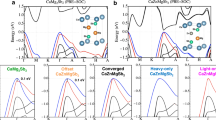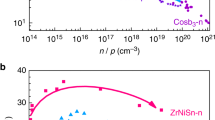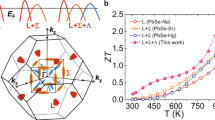Abstract
Aliovalent doping is a way to optimize the electrical properties of semiconductors, but its impact on the phonon structure and propagation is seldom considered properly. Here we show that aliovalent doping can be much more effective in reducing the lattice thermal conductivity of thermoelectric semiconductors than the commonly employed isoelectronic alloying strategy. We demonstrate this in the heavy-band NbFeSb system, finding that a reduction of 65% in the lattice thermal conductivity is achieved through only 10% aliovalent Hf doping, compared with the four times higher isoelectronic Ta alloying. We show that aliovalent doping introduces free charge carriers and enhances screening, leading to the softening and deceleration of optical phonons. Moreover, the heavy dopant can induce the avoided crossing of acoustic and optical phonon branches, decelerating the acoustic phonons. These results highlight the significant role of aliovalent dopants in regulating the phonon structure and suppressing the phonon propagation of semiconductors.
This is a preview of subscription content, access via your institution
Access options
Access Nature and 54 other Nature Portfolio journals
Get Nature+, our best-value online-access subscription
$29.99 / 30 days
cancel any time
Subscribe to this journal
Receive 12 print issues and online access
$209.00 per year
only $17.42 per issue
Buy this article
- Purchase on Springer Link
- Instant access to full article PDF
Prices may be subject to local taxes which are calculated during checkout





Similar content being viewed by others
Data availability
All data that support the findings of this study are available from the corresponding authors upon reasonable request. Experimental data from the ISIS Neutron and Muon Source are available at https://doi.org/10.5286/ISIS.E.RB1820186. Source data are provided with this paper.
Code availability
The codes that support the findings of this study are available from the corresponding authors upon reasonable request.
References
He, J. & Tritt, T. M. Advances in thermoelectric materials research: looking back and moving forward. Science 357, eaak9997 (2017).
Wang, F. et al. Technologies and perspectives for achieving carbon neutrality. Innov. 2, 100180 (2021).
Snyder, G. J. & Toberer, E. S. Complex thermoelectric materials. Nat. Mater. 7, 105–114 (2008).
Shakouri, A. Recent developments in semiconductor thermoelectric physics and materials. Annu. Rev. Mater. Res. 41, 399–431 (2011).
Ren, Q. et al. Establishing the carrier scattering phase diagram for ZrNiSn-based half-Heusler thermoelectric materials. Nat. Commun. 11, 3142 (2020).
Hu, C., Xia, K., Fu, C., Zhao, X. & Zhu, T. Carrier grain boundary scattering in thermoelectric materials. Energy Environ. Sci. 15, 1406–1422 (2022).
Ioffe, A. F. Semiconductor Thermoelements, and Thermoelectric Cooling (Infosearch, 1957).
Yu, J. et al. Half‐Heusler thermoelectric module with high conversion efficiency and high power density. Adv. Energy Mater. 10, 2000888 (2020).
Freer, R. et al. Key properties of inorganic thermoelectric materials—tables (version 1). J. Phys.: Energy 4, 022002 (2022).
Liu, Y. et al. Lanthanide contraction as a design factor for high-performance half-Heusler thermoelectric materials. Adv. Mater. 30, 1800881 (2018).
Zhu, H. et al. Understanding the asymmetrical thermoelectric performance for discovering promising thermoelectric materials. Sci. Adv. 5, eaav5813 (2019).
Yu, J. et al. Unique role of refractory Ta alloying in enhancing the figure of merit of NbFeSb thermoelectric materials. Adv. Energy Mater. 8, 1701313 (2018).
Zhu, H. et al. Discovery of ZrCoBi based half Heuslers with high thermoelectric conversion efficiency. Nat. Commun. 9, 2497 (2018).
Xing, Y. et al. A device-to-material strategy guiding the ‘double-high’ thermoelectric module. Joule 4, 2475–2483 (2020).
Xie, H. et al. The intrinsic disorder related alloy scattering in ZrNiSn half-Heusler thermoelectric materials. Sci. Rep. 4, 6888 (2015).
Fu, C., Zhu, T., Liu, Y., Xie, H. & Zhao, X. Band engineering of high performance p-type FeNbSb based half-Heusler thermoelectric materials for figure of merit zT > 1. Energy Environ. Sci. 8, 216–220 (2015).
Pei, Y. et al. Optimum carrier concentration in n-type PbTe thermoelectrics. Adv. Energy Mater. 4, 1400486 (2014).
Wang, H., LaLonde, A. D., Pei, Y. & Snyder, G. J. The criteria for beneficial disorder in thermoelectric solid solutions. Adv. Funct. Mater. 23, 1586–1596 (2013).
Hu, L., Zhu, T., Liu, X. & Zhao, X. Point defect engineering of high-performance bismuth-telluride-based thermoelectric materials. Adv. Funct. Mater. 24, 5211–5218 (2014).
Yang, J., Meisner, G. P. & Chen, L. Strain field fluctuation effects on lattice thermal conductivity of ZrNiSn-based thermoelectric compounds. Appl. Phys. Lett. 85, 1140–1142 (2004).
Liu, Y. et al. Demonstration of a phonon-glass electron-crystal strategy in (Hf,Zr)NiSn half-Heusler thermoelectric materials by alloying. J. Mater. Chem. A 3, 22716–22722 (2015).
Fu, C. et al. High band degeneracy contributes to high thermoelectric performance in p-type half-Heusler compounds. Adv. Energy Mater. 4, 1400600 (2014).
May, A. F. & Snyder, G. J. Introduction to modeling thermoelectric transport at high temperatures. in Materials, Preparation, and Characterization in Thermoelectrics 207–224 (CRC Press, 2017).
Togo, A. & Tanaka, I. First principles phonon calculations in materials science. Scr. Mater. 108, 1–5 (2015).
Li, W., Carrete, J., A. Katcho, N. & Mingo, N. ShengBTE: a solver of the Boltzmann transport equation for phonons. Comput. Phys. Commun. 185, 1747–1758 (2014).
Giannozzi, P. et al. QUANTUM ESPRESSO: a modular and open-source software project for quantum simulations of materials. J. Phys.: Condens. Matter 21, 395502 (2009).
Noffsinger, J. et al. EPW: a program for calculating the electron–phonon coupling using maximally localized Wannier functions. Comput. Phys. Commun. 181, 2140–2148 (2010).
Tritt, T. M. Thermal Conductivity (Springer, 2004).
Max, B. & Kun, H. Dynamical Theory of Crystal Lattices (Clarendon Press, 1954).
Kandpal, H. C., Felser, C. & Seshadri, R. Covalent bonding and the nature of band gaps in some half-Heusler compounds. J. Phys. D: Appl. Phys. 39, 776–785 (2006).
Dronskowski, R. & Bloechl, P. E. Crystal orbital Hamilton populations (COHP): energy-resolved visualization of chemical bonding in solids based on density-functional calculations. J. Phys. Chem. 97, 8617–8624 (1993).
Deringer, V. L., Tchougréeff, A. L. & Dronskowski, R. Crystal Orbital Hamilton Population (COHP) analysis as projected from plane-wave basis sets. J. Phys. Chem. A 115, 5461–5466 (2011).
Maintz, S., Deringer, V. L., Tchougréeff, A. L. & Dronskowski, R. Analytic projection from plane-wave and PAW wavefunctions and application to chemical-bonding analysis in solids. J. Comput. Chem. 34, 2557–2567 (2013).
Nelson, R. et al. LOBSTER: local orbital projections, atomic charges, and chemical‐bonding analysis from projector‐augmented‐wave‐based density‐functional theory. J. Comput. Chem. 41, 1931–1940 (2020).
Callaway, J. & von Baeyer, H. C. Effect of point imperfections on lattice thermal conductivity. Phys. Rev. 120, 1149–1154 (1960).
Dong, J., Sankey, O. F. & Myles, C. W. Theoretical study of the lattice thermal conductivity in Ge framework semiconductors. Phys. Rev. Lett. 86, 2361–2364 (2001).
Yang, J. et al. On the tuning of electrical and thermal transport in thermoelectrics: an integrated theory–experiment perspective. npj Comput. Mater. 2, 15015 (2016).
Christensen, M. et al. Avoided crossing of rattler modes in thermoelectric materials. Nat. Mater. 7, 811–815 (2008).
Tamura, S. Isotope scattering of dispersive phonons in Ge. Phys. Rev. B 27, 858–866 (1983).
Delaire, O. et al. Heavy-impurity resonance, hybridization, and phonon spectral functions in Fe1–xMxSi (M = Ir, Os). Phys. Rev. B 91, 094307 (2015).
Wu, Y. et al. Lattice strain advances thermoelectrics. Joule 3, 1276–1288 (2019).
Slack, G. A. & Galginaitis, S. Thermal conductivity and phonon scattering by magnetic impurities in CdTe. Phys. Rev. 133, A253–A268 (1964).
Slack, G. A. Effect of isotopes on low-temperature thermal conductivity. Phys. Rev. 105, 829–831 (1957).
Klemens, P. G. Thermal resistance due to point defects at high temperatures. Phys. Rev. 119, 507–509 (1960).
Abeles, B. Lattice thermal conductivity of disordered semiconductor alloys at high temperatures. Phys. Rev. 131, 1906–1911 (1963).
Delaire, O. et al. Phonon softening and metallization of a narrow-gap semiconductor by thermal disorder. Proc. Natl Acad. Sci. USA 108, 4725–4730 (2011).
Racu, A. M., Menzel, D., Schoenes, J. & Doll, K. Crystallographic disorder and electron-phonon coupling in Fe1–xCoxSi single crystals: Raman spectroscopy study. Phys. Rev. B. 76, 115103 (2007).
Menzel, D. et al. Electron-phonon interaction and spectral weight transfer in Fe1–xCoxSi. Phys. Rev. B. 79, 165111 (2009).
Koza, M. M. et al. Breakdown of phonon glass paradigm in La- and Ce-filled Fe4Sb12 skutterudites. Nat. Mater. 7, 805–810 (2008).
Huang, B. & Kaviany, M. Filler-reduced phonon conductivity of thermoelectric skutterudites: ab initio calculations and molecular dynamics simulations. Acta Mater. 58, 4516–4526 (2010).
Li, W. & Mingo, N. Thermal conductivity of fully filled skutterudites: role of the filler. Phys. Rev. B. 89, 184304 (2014).
Li, W. & Mingo, N. Ultralow lattice thermal conductivity of the fully filled skutterudite YbFe4Sb12 due to the flat avoided-crossing filler modes. Phys. Rev. B. 91, 144304 (2015).
Lin, H. et al. Concerted rattling in CsAg5Te3 leading to ultralow thermal conductivity and high thermoelectric performance. Angew. Chem. Int. Ed. 55, 11431–11436 (2016).
He, J. et al. Ultralow thermal conductivity in full Heusler semiconductors. Phys. Rev. Lett. 117, 046602 (2016).
Tan, G., Hao, S., Zhao, J., Wolverton, C. & Kanatzidis, M. G. High thermoelectric performance in electron-doped AgBi3S5 with ultralow thermal conductivity. J. Am. Chem. Soc. 139, 6467–6473 (2017).
Azuah, R. T. et al. DAVE: a comprehensive software suite for the reduction, visualization, and analysis of low energy neutron spectroscopic data. J. Res. Natl Inst. Stand. Technol. 114, 341–358 (2009).
Lin, J. Y. Y., Islam, F. & Kresh, M. Multiphonon: phonon density of states tools for inelastic neutron scattering powder data. J. Open Source Softw. 3, 440 (2018).
Ren, Q. et al. Ultrasensitive barocaloric material for room-temperature solid-state refrigeration. Nat. Commun. 13, 2293 (2022).
Ren, Q. et al. Extreme phonon anharmonicity underpins superionic diffusion and ultralow thermal conductivity in argyrodite Ag8SnSe6. Nat. Mater. 22, 999–1006 (2023).
Blöchl, P. E. Projector augmented-wave method. Phys. Rev. B 50, 17953–17979 (1994).
Kresse, G. & Furthmüller, J. Efficient iterative schemes for ab initio total-energy calculations using a plane-wave basis set. Phys. Rev. B 54, 11169–11186 (1996).
Perdew, J. P., Burke, K. & Ernzerhof, M. Generalized gradient approximation made simple. Phys. Rev. Lett. 77, 3865–3868 (1996).
Acknowledgements
T.Z. thanks the National Natural Science Foundation of China (no. 92163203), the National Science Fund for Distinguished Young Scholars (no. 51725102) and the Fundamental Research Funds for the Central Universities (no. 2021FZZX001) for support. C. Fu thanks the National Natural Science Foundation of China (no. 52101275) and the Fundamental Research Funds for the Central Universities (no. 226-2023-00001). J.Y. thanks the National Natural Science Foundation of China (nos. 52172216 and 92163212) and the Key Research Project of Zhejiang Lab (no. 2021PE0AC02). J.M. thanks the National Science Foundation of China (no. U2032213) for support. C. Felser thanks the Deutsche Forschungsgemeinschaft (DFG, German Research Foundation)—Projektnummer (no. 392228380). Q.R. thanks the project from Guangdong Basic and Applied Basic Research Foundation (grant no. 2021B1515140014). Q.R. also acknowledges the beam time granted by ISIS (RB no. 1820186), SINQ (proposal no. 20181498) and J-PARC/MLF (proposal no. 2018B0144). P.M. thanks the National Natural Science Foundation of China (no. 12005243) and the Guangdong Basic and Applied Basic Research Foundation (grant no. 2022B1515120014).We thank J. Yu and K. Xia for helpful discussions.
Author information
Authors and Affiliations
Contributions
C. Fu and T.Z. designed the project. S.H. prepared the samples and carried out the high-temperature transport measurements. C. Fu and C. Felser performed the low-temperature transport measurements. S.D. and J.Y. performed the first-principles calculations. Q.R. and J.M. carried out the INS experiment and high-resolution neutron diffraction studies with input from M.D.L., D.S., P.M., S.T. and T.K. Q.R. and J.M. analyzed the neutron scattering data and Q.R. carried out the Rietveld refinement of the neutron diffraction patterns. S.H. and C. Fu analysed the data and wrote the original manuscript, with input from C.H. and Z.G. T.Z. and C. Felser supervised the project. All the authors reviewed and edited the manuscript.
Corresponding authors
Ethics declarations
Competing interests
The authors declare no competing interests.
Peer review
Peer review information
Nature Physics thanks Zhilun Lu and the other, anonymous, reviewer(s) for their contribution to the peer review of this work.
Additional information
Publisher’s note Springer Nature remains neutral with regard to jurisdictional claims in published maps and institutional affiliations.
Supplementary information
Supplementary Information
Supplementary Figs. 1–13, Tables 1–7 and Discussion.
Source data
Source Data Fig. 1
Optimal carrier concentration data versus DOS effective mass (Fig. 1a) and reduction in lattice thermal conductivity versus doping/alloying concentration (Fig. 1b).
Source Data Fig. 2
Experimental lattice thermal conductivity data (Fig. 2a) and calculated lattice thermal conductivity data (Fig. 2b–d).
Source Data Fig. 3
INS data (Fig. 3a,b), calculated phonon DOS (Fig. 3b) and group velocity data (Fig. 3c).
Source Data Fig. 4
Calculated phonon dispersion data (Fig. 4a,b), integrated partial COHP data (Fig. 4c) and deformation electron density isosurface (Fig. 4d).
Source Data Fig. 5
Calculated group velocity data (Fig. 5a), phonon dispersion data (Fig. 5b) and partial phonon DOS data (Fig. 5c).
Rights and permissions
Springer Nature or its licensor (e.g. a society or other partner) holds exclusive rights to this article under a publishing agreement with the author(s) or other rightsholder(s); author self-archiving of the accepted manuscript version of this article is solely governed by the terms of such publishing agreement and applicable law.
About this article
Cite this article
Han, S., Dai, S., Ma, J. et al. Strong phonon softening and avoided crossing in aliovalence-doped heavy-band thermoelectrics. Nat. Phys. 19, 1649–1657 (2023). https://doi.org/10.1038/s41567-023-02188-z
Received:
Accepted:
Published:
Issue Date:
DOI: https://doi.org/10.1038/s41567-023-02188-z
This article is cited by
-
Vacancies tailoring lattice anharmonicity of Zintl-type thermoelectrics
Nature Communications (2024)
-
Phonon slowdown
Nature Physics (2023)



